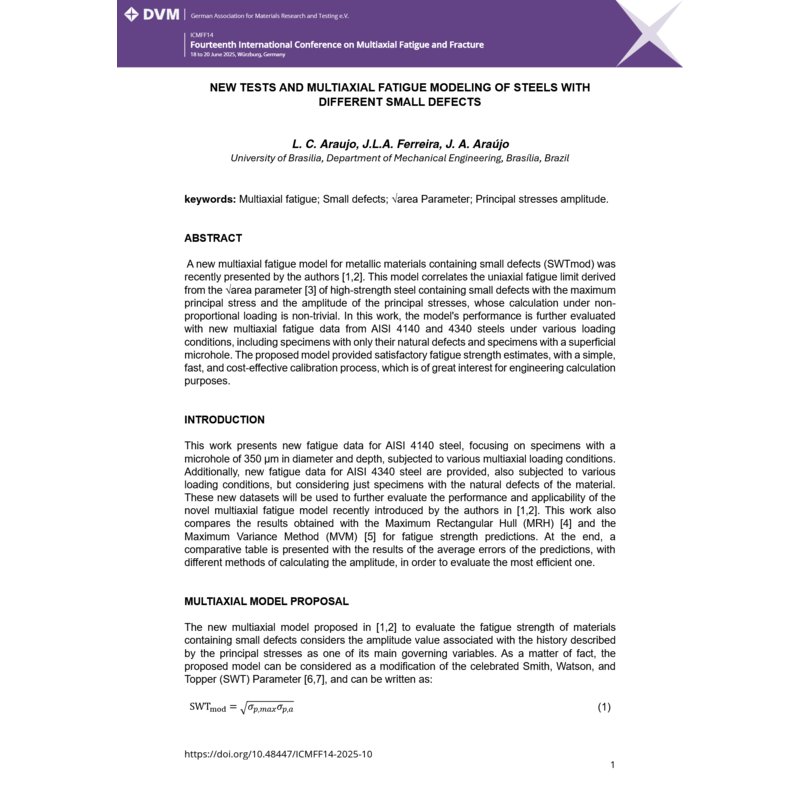- Nur online erhältlich



A new multiaxial fatigue model for metallic materials containing small defects (SWTmod) was recently presented by the authors [1-2]. This model correlates the uniaxial fatigue limit derived from the √area parameter [3] of high-strength steel containing small defects with the maximum principal stress and the amplitude of the principal stresses, whose calculation under non-proportional loading is non-trivial. In this work the model's performance is further evaluated with new multiaxial fatigue data from AISI 4140 and 4340 steels under various loading conditions, including specimens with only their natural defects and specimens with a superficial microhole. The proposed model provided satisfactory fatigue strength estimates, with a simple, fast, and cost-effective calibration…

Datenschutzbedingungen (bearbeiten im Modul "Kundenvorteile")

Lieferbedingungen (bearbeiten im Modul "Kundenvorteile")

Rücksendebedingungen (bearbeiten im Modul "Kundenvorteile")
A new multiaxial fatigue model for metallic materials containing small defects (SWTmod) was recently presented by the authors [1-2]. This model correlates the uniaxial fatigue limit derived from the √area parameter [3] of high-strength steel containing small defects with the maximum principal stress and the amplitude of the principal stresses, whose calculation under non-proportional loading is non-trivial. In this work the model's performance is further evaluated with new multiaxial fatigue data from AISI 4140 and 4340 steels under various loading conditions, including specimens with only their natural defects and specimens with a superficial microhole. The proposed model provided satisfactory fatigue strength estimates, with a simple, fast, and cost-effective calibration process, which is of great interest for engineering calculation purposes.
The new model can be considered as a modification of the celebrated Smith, Watson, and Topper (SWT) Parameter, and can be written as:
SWTmod = √(σp,maxσp,a)
where SWTmod represents the Modified Smith, Watson and Topper parameter, σp,max is the maximum value of the greatest principal stress at any time instant during the loading cycle and σp,a is the amplitude of the principal stresses. As mentioned before, the computation of such amplitude value is not trivial. This relationship has the advantage of not relying on any material constant. At last, a mechanical component containing a small defect subjected to a loading history will be considered safe if the following inequality holds:
SWTmod ≤ σw
where σw is the uniaxial fatigue limit from the √area parameter.
In the new model, mathematical methods conventionally used to compute the amplitude of the shear stress are now used to find the amplitude of the principal stresses. Specifically, this work compares the results obtained with the Maximum Rectangular Hull (MRH) [4] and the Maximum Variance Method (MVM) [5] for fatigue strength predictions. Satisfactory results were achieved in the evaluation of the SWTmod with new experimental data, figures 1 and 2 shown the comparison between data points of 4140 and 4340 steels, respectively, and the fatigue strength prediction line. In the figures the prediction line, solid line, divides the safe region from the failure region, that is, for loads that generate stresses below this curve, failure is not expected, and failure is expected for stresses above it, the full symbols refer to specimens that failed, whereas the empty ones refer to run-outs. There are some symbols that are superimposed, showing stress levels where there were both failures and run-outs.
The accuracy of the criterion was evaluated through an error index, by using the Maximum Variance Method (MVM) to compute the principal stress amplitude better results were obtained, as observed in previous works, here the average error for all tests conducted was 20.54%. Notably, all errors observed were conservative, meaning they were in favor of safety.
In conclusion, the new model, coupled with the use of the √area parameter and the MVM, offers a robust approach to fatigue endurance prediction, especially in the presence of small defects. By eliminating the need for exhaustive defect-specific testing, it presents a highly efficient solution for industrial applications, ensuring both accuracy and safety in fatigue design. Further research may investigate the extension of the model to other materials and defect geometries to explore its full potential in multiaxial fatigue loading scenarios.